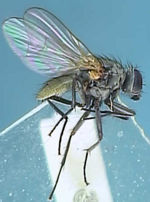Difference between revisions of "Hydrotaea irritans"
Jump to navigation
Jump to search
| Line 1: | Line 1: | ||
[[Image:Hydrotaea irritans.jpg|thumb|right|150px|H.irritans female - Copyright Alan Hadley]] | [[Image:Hydrotaea irritans.jpg|thumb|right|150px|H.irritans female - Copyright Alan Hadley]] | ||
[[Image:Hydrotaea irritans male.jpg|thumb|right|150px|H.irritans male - Copyright Alan Hadley]] | [[Image:Hydrotaea irritans male.jpg|thumb|right|150px|H.irritans male - Copyright Alan Hadley]] | ||
| − | |||
| − | + | ==Hosts== | |
| − | + | Cattle, sheep, and horses. | |
| − | |||
| − | |||
| − | |||
| − | |||
| − | == | ||
| − | |||
| − | |||
| − | |||
| − | |||
| − | |||
| + | ==Identification== | ||
| + | ''H. irritans'' is morphologically very similar in appearance to [[Musca spp.|''Musca'']]. The adult flies are 4-7mm in length, have a green thorax and a yellow abdomen. | ||
==Life Cycle== | ==Life Cycle== | ||
| − | + | The female lays eggs in the faeces, or decaying vegetation. Eggs then hatch into larvae in the autumn, and begin to mature. However, development is haltered until the following spring. They then undergo pupation, and maturation is complete. Adults emerge in summer. | |
| − | |||
| − | |||
| − | |||
| − | |||
| − | |||
| − | |||
Revision as of 16:17, 20 July 2010
Hosts
Cattle, sheep, and horses.
Identification
H. irritans is morphologically very similar in appearance to Musca. The adult flies are 4-7mm in length, have a green thorax and a yellow abdomen.
Life Cycle
The female lays eggs in the faeces, or decaying vegetation. Eggs then hatch into larvae in the autumn, and begin to mature. However, development is haltered until the following spring. They then undergo pupation, and maturation is complete. Adults emerge in summer.
Pathogenesis
- Cattle
- Evidence suggests that they transmit summer mastitis
- Sheep
- Cause extreme irritation
- Mouthparts rasp the skin to feed on secretions and exudate
- Leads to self-inflicted damage
- E.g. 'Broken Head'
- Secondary bacterial infection may occur
- Blowfly strike may follow
- Cause extreme irritation

